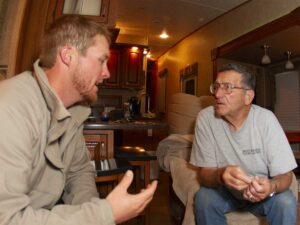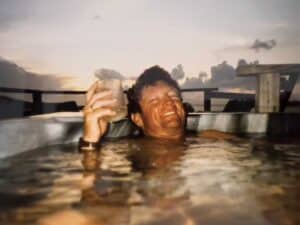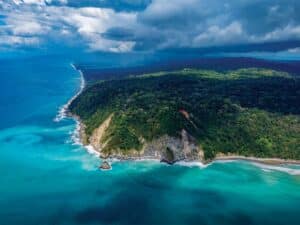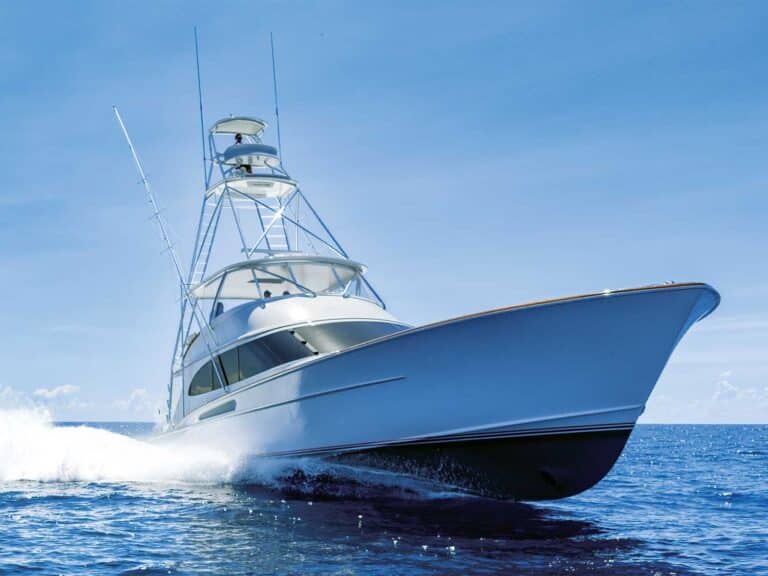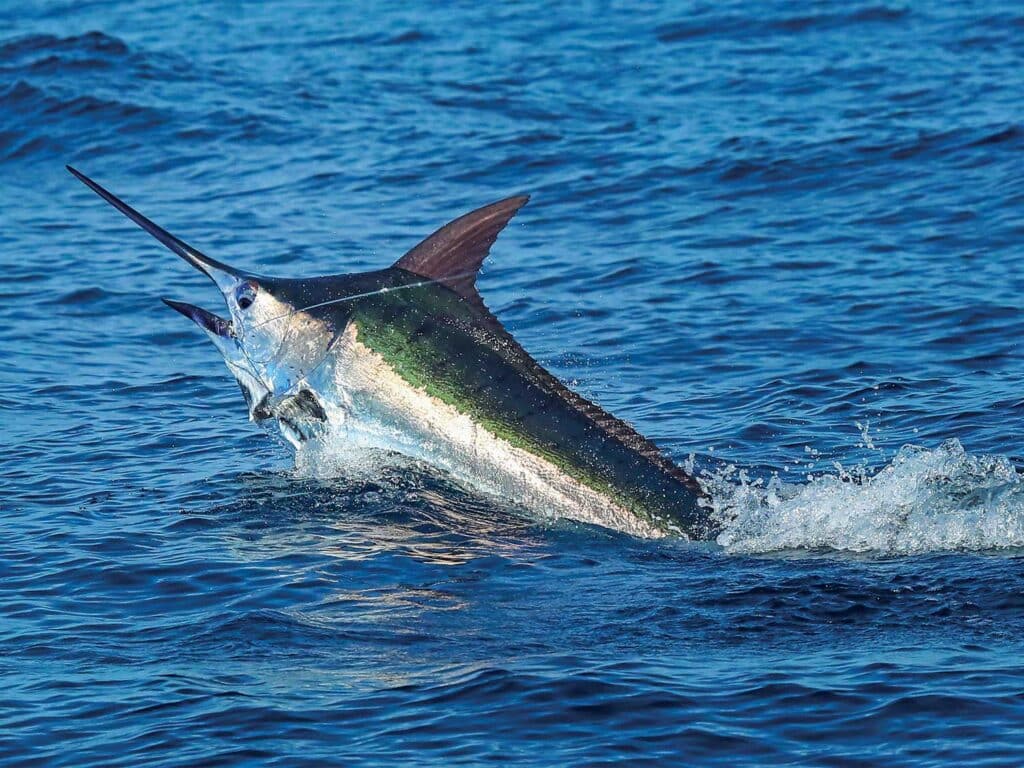
Subscribe to Marlin magazine and get a year of highly collectible, keepsake editions – plus access to the digital edition and archives. Sign up for the free Marlin email newsletter.
In the world of blue marlin fishing, it’s not often that you can say you’re venturing into virtually unexplored waters known to hold giant fish. But in 1998, that was exactly what Dr. Guy Harvey and I set out to do when we traveled to Mindelo on Sao Vicente Island in Cape Verde, Africa. We were joining the renowned mothership crew of Madam and Hooker: Capt. Trevor Cockle and mates-turned-captains Randy Baker and Ronnie Fields.
Our goal wasn’t just to catch blue marlin—it was to film them underwater and better understand how these billfish use their bills to feed. At the time, there were many theories on this. Today, thanks in part to expeditions like ours, there are far fewer. There are, however, many questions remaining as to why Cape Verde is the blue marlin mecca in the Atlantic.

Back to Where It All Began
Over the past 27 years, much has changed. Once a sleepy, tourism-starved archipelago 320 to 460 nautical miles off Dakar, Cape Verde has transformed. This year, Harvey and I returned to see firsthand how commerce, fishing activity and accommodations have evolved, and, more importantly, to assess the current state of the blue marlin fishery.
French angler and Madeira resident Benjamin Vial invited me to Cape Verde to fish with Harvey, Larry Cobado and Flint Besecker. In addition to fishing, Besecker had purchased four mini PSATs (pop-up satellite archival tags) from the IGFA Great Marlin Race. These tags will help Dr. Barbara Block at Stanford’s Hopkins Marine Station analyze marlin travel patterns in and around Cape Verde.
Once collected, this data can be compared to tagging data sets being deployed in other islands of the eastern Atlantic’s Macaronesia region (Madeira, the Azores and the Canary Islands), thus painting a bigger picture of blue marlin movements in this area of the world. It’s now common knowledge that this region holds some massive female blue marlin that are here to either breed or feed.
Although we still have questions about why these big fish are in the area, one thing is for certain: Cape Verde is no longer the secret it was at the turn of this century.
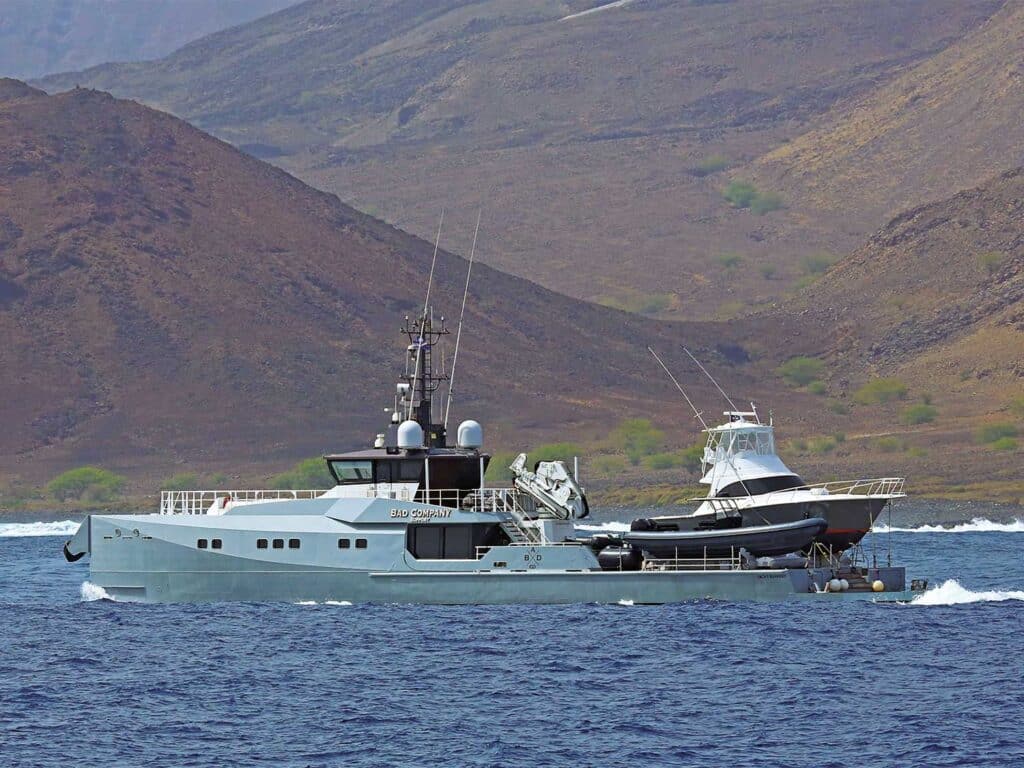
Wind, Weather and the Lee Side
Cape Verde—or Cabo Verde in Portuguese, the country’s official language—means green cape. With only a few months of measurable rain in these islands (typically August through October), green is more often desert brown. From December through June, Cape Verde is prone to northeast trade winds that blow Saharan dust across hundreds of miles of open ocean, a phenomenon referred to as the Harmattan winds. These unrelenting winds can hamper an angler’s ability to explore more ocean to discover what really swims in these waters. With that said, the fleet typically huddles its daily effort in the calm lee areas behind the islands of Sao Vicente, Santo Antao, Sao Nicolau and the iconic San Pedro point. I’ve long wondered what number and size of blue marlin could be caught if these winds didn’t limit the effort to such select areas.
When Dr. Harvey and I fished with the Madam and Hooker crew back in 1998, the infancy of this fishery, only a few boats were exploring the area. We fished the lee of Sao Vicente, passing the famous lighthouse on San Pedro point, then crossed the seven-mile channel to the west side of Santo Antao, where we made several brave jaunts to the exposed Banco Noroweste about 18 miles away. Back then, the bank was full of wahoo, yellowfin tuna and blue marlin.

For this most recent trip, we fished aboard a smaller boat, a 37-foot Bertram called Smoker. As a result, we didn’t venture to the bank but instead fished the lee waters of Santo Antao and made a great trip of it. Other boats in the fleet concentrated their fishing in the lee of Sao Nicolau, about a 50-mile run from Mindelo. In that area, Capt. Steve Lassley aboard Bad Company and Capt. Marty Bates aboard The Release Man found great numbers of blues. On many days, they raised and released between five and 15 fish up to 800-plus pounds.
Cape Verde lends itself to trolling lures. Most boats run two rigged lures on the longs and two hookless bridge teasers on the shorts, followed up by a circle hook rigged with horse ballyhoo, flying fish or bullet tuna as a pitch bait. Live bait is rare. “The inconsistent concentration of adequate bait species, such as skipjack, small yellowfin or bullet tuna, makes it difficult,” says Smoker’s Capt. Luis Roque, who has fished Cape Verde for 12 seasons. “Plus, few boats in the fleet have tuna tubes to keep these baits alive over time.” In turn, lures allow boats to cover more ground and increase their odds.

Technology and Transformation
Back in 1998, Cape Verde was truly off the radar. Only a handful of boats fished these waters, including German angler Dieter Vogel, who “lone-wolfed it” here for several seasons. But word of big blues spread quickly, prompting Jerry and Debra Dunaway to bring their Madam and Hooker operation 23 days across the Atlantic.
What has been the biggest change since then? The obvious growth of the sport-fishing fleet, with groups such as Atlantic Fishing Charters now offering quality boats, crew and gear to pursue big blues. And American sport-fishers have arrived in force, equipped with omnidirectional sonar. The difference is significant. Omni-equipped boats, like Anthony Hsieh’s Bad Company and Sam Peters’ The Release Man, consistently outperform those without the sonar. Their consistent daily catch rates convincingly tell the story of how much difference these machines make in this fishery. For instance, a boat with an omni sonar may see over 20 blues, depending on depth, and perhaps raise a dozen and get bites from a high percentage. Meanwhile, a boat without sonar may only raise a few and catch a fraction of that.
With more boats with omni-sonar capability fishing these islands in the years ahead and communication among the fleet ever-improving, we should be able to more accurately assess blue marlin abundance in Cape Verde.

Why Cape Verde?
Thanks to the invaluable tagging efforts of passionate anglers, we are starting to get some answers. For example, working with Block, Bad Company has deployed 10 PSATs in Cape Verde and 40 across the Atlantic. Early findings suggest the blue marlin in Cape Verde are merely passing through this archipelago on their way to the northerly islands of Macaronesia. They then head eastward to the West Africa coast, where high concentrations of tuna have migrated for decades.
The presence of small (sub-200-pound) marlin suggests strong population structure and male abundance, boosting the odds of double-digit catch days. Contrast that with Madeira, a trophy fishery where you’re more likely to see just one marlin every other day, but when you do, it’s typically a giant.
Interestingly, when talking with Hsieh and others about their observations in Cape Verde, they note very little interaction between different class sizes of blue marlin, unlike that of black marlin on Australia’s Great Barrier Reef. This could suggest limited spawning activity takes place in Cape Verde. To confirm spawning behavior, biologists would need to conduct nighttime plankton tows to capture larval marlin, as has been done in Kona. There, the consistent presence of marlin larvae proves its importance as a spawning site. While less glamorous than tagging adults, these studies can redefine our understanding of marlin migrations.
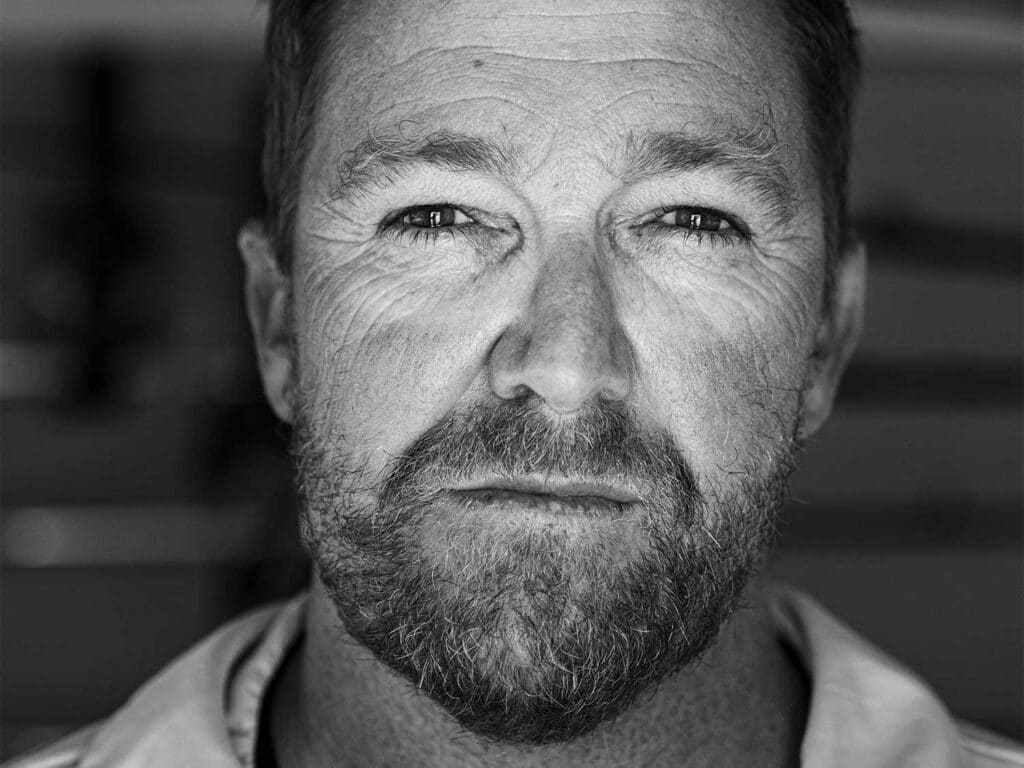
The People Behind the Fishery
Over the past 20 years, Cape Verde has become a magnet for elite captains and crews chasing world-class blue marlin. Bates has fished the region for 19 years and knows it intimately. With his omni sonar, he’s had many 10-plus release days, often with fish in the 700- to 1,000-pound range. He notes that from December to June, the trade winds confine boats to the leeward zones. But as his clientele list expands from July to September, Bates says the calmer seas of these months allow the fleet to venture out and discover new hunting grounds.
We spent several days fishing aboard Smoker with Roque and mates Martini Palmer and JahJah Moreira. Besecker successfully deployed all four mini PSATs, tagging marlin of 150, 200, 400 and 800 pounds. The 800-pounder was the trip’s crown jewel, expertly wired and released by the crew. Smoker is no stranger to big fish. The crew released the second-largest blue marlin caught on rod and reel in the Atlantic—a 1,370-pounder hooked just minutes after leaving Tarrafal on Santo Antao. Palmer’s work on the wire that day is still talked about.
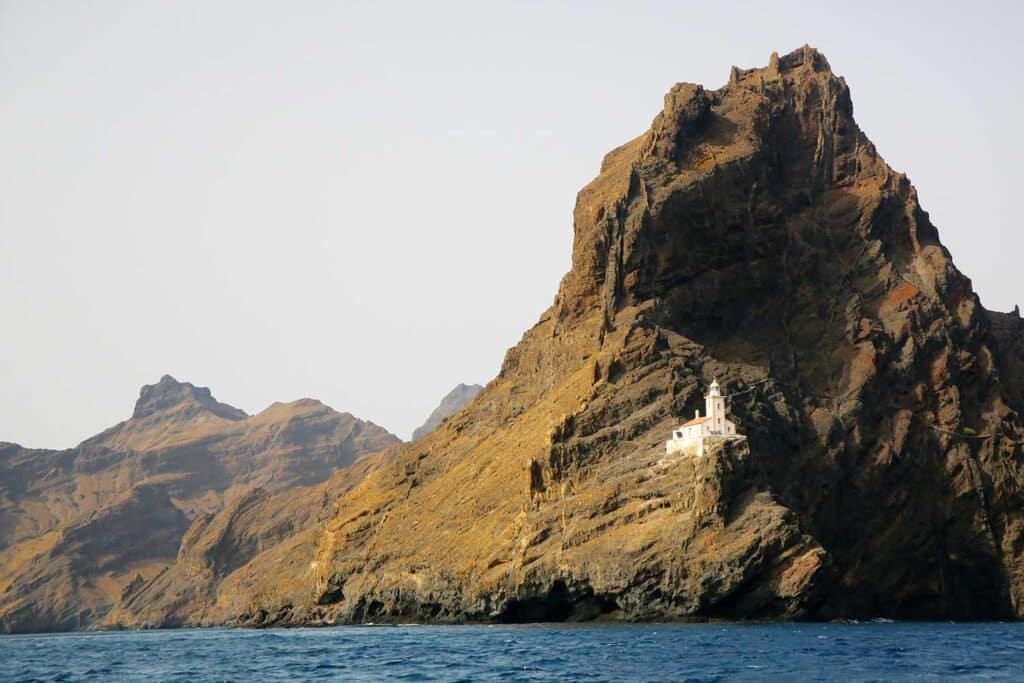
Closing Thoughts
During our trip, Dr. Harvey and I took note of other species present to form a broader fisheries perspective, helping us analyze why blue marlin are found here in such remarkable numbers. In addition to several whale sharks, we encountered a variety of marine mammals, including dolphins, pilot whales and humpback whales. These apex predators and filter feeders are excellent indicators of bait resource abundance and overall ecosystem health. After all, unlike us visiting anglers, those blue marlin aren’t on vacation—they’re here for a reason, and that reason is food.
Cape Verde has come a long way since those early exploratory trips aboard Madam and Hooker with Cockle and the boys. It remains raw and wild, but is now far more accessible, with quality boats, seasoned crews, and a growing infrastructure to support serious fishing expeditions.
The fish are big and abundant, and each season uncovers new insights through advancing sonar, tagging technology, and collaboration between captains, crews and researchers. But beyond the science lies the soul of this fishery: giant blues in cobalt water, fished by some of the best in the business. And while there are still many questions surrounding Cape Verde, one thing is for certain: It won’t be another 27 years before I return.
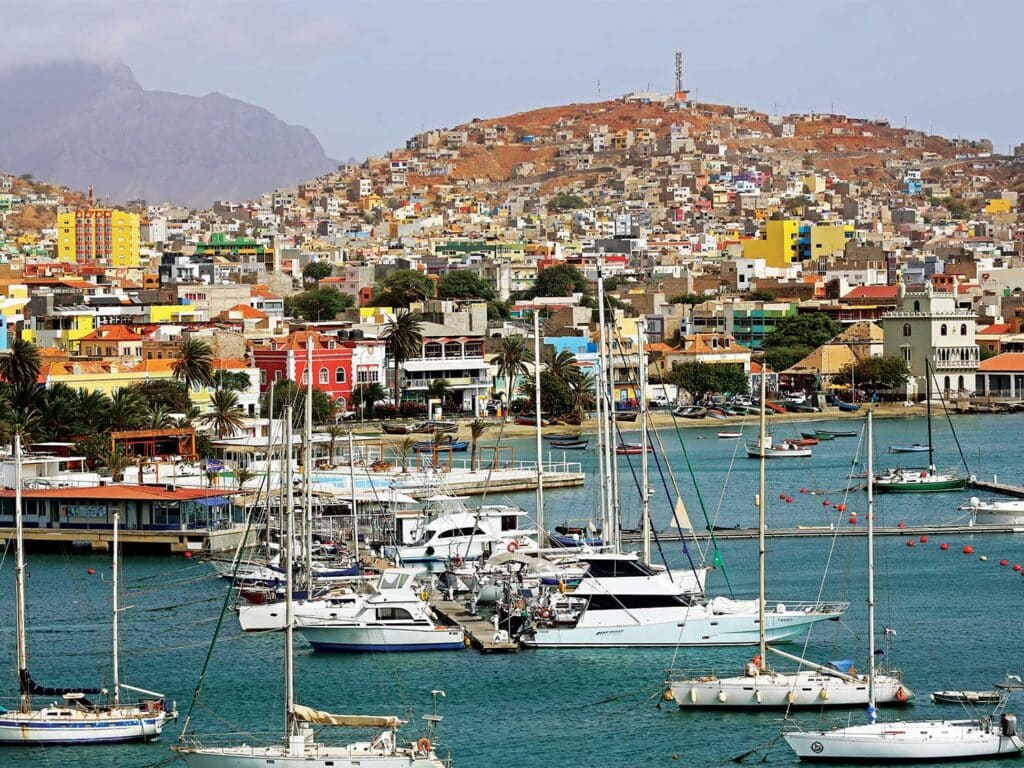
Getting to Cape Verde
In 1998, the only way to reach Sao Vicente was a puddle-jumper flight from Sal Island. Today, a direct four-hour flight from Lisbon delivers anglers just 15 minutes by taxi from the docks of Mindelo. The once dusty port town is now a vibrant commercial hub with shipping facilities, a cannery, waterfront promenades, hotels and restaurants. Tourism has grown beyond international anglers, attracting northern Europeans seeking warm beaches at reasonable prices. According to the crews I spoke with, food, fuel, parts and provisions are now easy to obtain or ship in quickly. And when you’re this far off the grid, that really matters.
Fishing Cape Verde
- Atlantic Fishing Charters
- Hooker – 43′ G&S
- Smoker – 37′ Bertram
- Sambo – 36′ Bertram
- Ryan Williamson Marlin Charters
- Capt. Marty Bates
